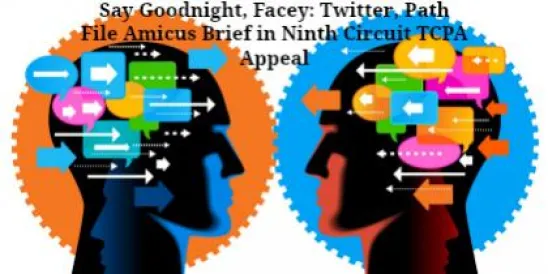The Los Angeles Lakers found allies recently in Twitter and Path, when the social media companies sided with the Lakers to oppose an appeal from a dismissal of a putative class action asserting TCPA claims based on allegedly unsolicited text messages. See Emanuel v. The Los Angeles Lakers, Inc., No. 13-55678 (9th Cir.)
During a 2012 preseason game, the Lakers invited patrons to “TEXT your message to 525377” if they wanted to have a personal message displayed on the Staples Center jumbotron. David Emanuel did just that, sending a text message that read: “I love you Facey. Happy Date Night.” He then received a text message from the team that advised him that the team had received, but might not display, his note: “Thnx! Txt as many times as you like. Not all msgs go on screen. Txt ALERTS for Lakers News alerts. Msg&Data Rates May Apply. Txt STOP to quit. Txt INFO for info.” (Plaintiff then texted “STOP” and received another text message confirming receipt of his request, which he does not claim violated the TCPA.)
Plaintiff promptly filed a putative class action, claiming that the text message violated the TCPA because he had not consented to receive it and because the Lakers had sent it using an ATDS, i.e., “equipment which has the capacity—(A) to store or produce telephone numbers to be called, using a random or sequential number generator; and (B) to dial such numbers.” 47 U.S.C. § 227(a). The Lakers moved to dismiss, arguing that Mr. Emanuel consented to the text message by sending a text message of his own, and that Mr. Emanuel had parroted the definition of an ATDS rather than pleaded any facts tending to show that one had been used.
District Court Judge George H. Wu agreed with the Lakers and dismissed the suit with prejudice. See Emanuel v. L.A. Lakers, Inc., 12-cv-9936, 2013 WL 1719035 (C.D. Ca. Apr. 18, 2013).
First, he found that Mr. Emanuel had consented to the text message by virtue of sending his own: “[A] ‘common sense] reading of the TCPA indicates that, by sending his original message, Plaintiff expressly consented to receiving a confirmatory text from the Lakers…. Indeed, when Plaintiff sought to display his love for ‘Facey’ on the Staples Center jumbotron via text, it is difficult to imagine how he could have been certain that the Lakers received his message without a confirmatory response.”
Second, he found that the text message was informational rather than intrusive: “Defendant’s message provided Plaintiff with information relevant to his request. Had Plaintiff been planning to inform his date that a special message was forthcoming, Defendants’ confirmatory response may have had the beneficial effect of tempering Plaintiff’s (or his date’s) expectations.”
Finally, he found that there were no well-pleaded facts tending to show that an ATDS had been used: “[T]he FAC fails to adequately plead that Defendant used an ATDS system…. [M]erely parroting this definition in the FAC is insufficient to state a claim …. In fact, much of Plaintiff’s FAC suggests that Defendant does not use a system that has the capacity to generate, or to sequentially or randomly dial numbers,” as “Plaintiff does not allege that he received the Lakers’ text ‘randomly’ but rather in direct response to Plaintiff’s initiating text.”
Mr. Emanuel then took an appeal. His opening brief and the Lakers’ answering brief are available here and here.
On November 21, Twitter (a microblogging service) and Path (a photo sharing and messaging service) joined the fray. Although we can’t help but think that the San Francisco-based companies usually root against the Lakers, they got on their soapboxes as only nonparties can, targeting Mr. Emanuel (“apparently a former employee of the plaintiffs’ firm that filed the suit”), his counsel (which “has filed numerous other TCPA suits, including one against Twitter”), and indeed the whole cottage industry of TCPA plaintiffs’ lawyers (which is transforming “a statute intended to curb vexatious telemarketing” into a “vehicle for vexatious lawsuits”). “This case,” they argue, “is a paradigmatic example of a vexatious claim. Mr. Emanuel suffered no invasion of privacy or any other actual injury, and he appears to have sued … not because the team engaged in wrongful conduct but instead because his lawyers see the prospect of a windfall damages recovery on behalf of a class of artificial ‘victims.’” They cautioned the court that, without “real checks on abusive TCPA litigation, strike suits like these will continue to proliferate, defendants will be compelled into coercive settlements, and legitimate uses of text messages by innovating companies and their users will be significantly threatened.” Hear, hear! As our own Seamus Duffy told Law360 when asked about the brief, “The thing about being an amicus is that the intervenor can do a full-throated policy attack on the case and plaintiffs’ bar that is difficult for the main defendant to do, because it can hit the court the wrong way and backfire on the defendant.”
The amici also encourage the Ninth Circuit to clarify the definition of an ATDS, something we’ve blogged about repeatedly: “Plaintiffs frequently argue … that equipment constitutes an ATDS if the device could somehow be modified in the future (in some unstated way) to provide the capacity to generate random or sequential numbers, even if that capacity is lacking at the time of the calls in question. By that logic, any personal smartphone (indeed, any toaster) could … meet the definition, and render any calls or texts from those devices actionable under the TCPA…. This Court can scuttle that fallacious argument by making clear that the TCPA applies only to devices that have the current capacity to randomly or sequentially generate numbers to be called at the time of the call at issue.”
We’ll be keeping a close eye on this case and will report back when the court issues a decision.




 />i
/>i

